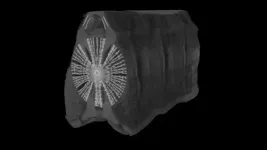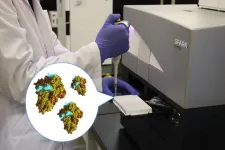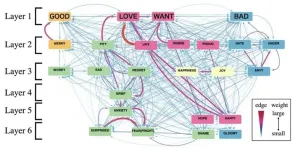(Press-News.org) Columbia researchers analyzing images from NASA’s James Webb Space Telescope have found that galaxies in the early universe are often flat and elongated, like breadsticks—and are rarely round, like balls of pizza dough. “Roughly 50 to 80% of the galaxies we studied appear to be flattened in two dimensions,” explained Viraj Pandya, a NASA Hubble Fellow at Columbia University, and the lead author of a new paper slated to appear in The Astrophysical Journal that outlines the findings. “Galaxies that look like long, thin breadsticks seem to be very common in the early universe, which is surprising, since they are uncommon among galaxies in the present-day universe.”
The team focused on a vast field of near-infrared images delivered by Webb, known as the Cosmic Evolution Early Release Science (CEERS) Survey, plucking out galaxies that are estimated to have existed when the universe was 600 million to 6 billion years old.
While most distant galaxies look like breadsticks, others are shaped like pizza pies and balls of pizza dough. The “balls of pizza dough,” or sphere-shaped galaxies, appear to be the smallest type of galaxy and were also the least frequently identified. The pizza pie-shaped galaxies were found to be as large as breadstick-shaped galaxies along their longest axis. “They are more common in the nearby universe which, due to the universe’s ongoing expansion, is made up of older, more mature galaxies.”
Which category would our Milky Way galaxy fall into if we were able to wind the clock back by billions of years? “Our best guess is that it might have appeared more like a breadstick,” said co-author Haowen Zhang, a PhD candidate at the University of Arizona in Tucson. This hypothesis is based partly on new evidence from Webb—theorists have “wound back the clock” to estimate the Milky Way’s mass billions of years ago, which suggests its likely breadstick shape in the distant past.
Images of what researchers believe are elongated, ellipsoid (i.e. breadstick-shaped) galaxies, captured with the James Webb Space Telescope. The word “believe” reflects the fact that some of the galaxies may be disk (i.e pizza pie) shaped galaxies seen from the side. (Credit: Viraj Pandya et al.)
These distant galaxies are also far less massive than nearby spirals and ellipticals—they are precursors to more massive galaxies like our own. “In the early universe, galaxies had had far less time to grow,” said Kartheik Iyer, a co-author and NASA Hubble Fellow also at Columbia University. “Identifying additional categories for early galaxies is exciting—there’s a lot more to analyze now. We can now study how galaxies’ shapes relate to how they look and better project how they formed in much more detail.”
Hubble, the space telescope that launched in 1990 and collects data to this day, “has long showed an excess of elongated galaxies,” explained co-author Marc Huertas-Company, a faculty research scientist at the Institute of Astrophysics on the Canary Islands. But researchers still wondered: Would additional detail show up better with the sensitivity to infrared light that the Webb telescope, which launched in 2021, has? “Webb confirmed that Hubble didn’t miss any additional features in the galaxies they both observed. Plus, Webb showed us many more distant galaxies with similar shapes, all in great detail,” Huertas-Company said.
One question, of course, is why early galaxies tended to be so flattened and elongated. One hypothesis, Pandya explained, is that the early universe may have been filled with filaments of dark matter that formed a kind of “skeletal background,” or “cosmic highway,” that ushered gas and stars along it. These filaments still exist, but they have grown much more diffuse as the universe has expanded, so they may be less likely to promote the formation of breadstick-shaped galaxies.
When researchers plotted galaxies’ aspect ratios against their longest axis length, they found the diagrams looked distinctly like bananas. (Credit: Pandya et al.)
The paper is called “Galaxies Going Bananas,” yet another food analogy that sprang into the authors’ minds as they looked at their data. When the authors plotted galaxies’ aspect ratios against their longest axis length, they found that the diagrams that emerged looked distinctly like bananas, a shape that reflects their elongated, ellipsoid (i.e. breadstick) shape. “The bananas are another way of saying that these intrinsically elongated galaxies seem to be the dominant ones in the first 4 billion years of the universe,” Pandya said.
There are still gaps in our knowledge. Researchers not only need an even larger sample size from Webb to further refine the properties and precise locations of distant galaxies, they will also need to spend ample time tweaking and updating their models to better reflect the precise geometries of distant galaxies. “These are early results,” said co-author Elizabeth McGrath, an associate professor at Colby College in Waterville, Maine. “We need to delve more deeply into the data to figure out what’s going on, but we’re very excited about these early trends.”
This article was adapted from a press release by NASA, which used the metaphor of pool noodles and surfboards to describe the paper’s findings.
END
New research shows that most early galaxies looked like breadsticks rather than pizza pies or dough balls
Data from NASA’s James Webb Space Telescope suggests that many early galaxies were long and thin, not disk-like or spherical.
2024-01-17
ELSE PRESS RELEASES FROM THIS DATE:
Podcasts and compulsory attendance improved student learning
2024-01-17
Consider a group of new sociology students who are about to dive into a completely new subject. Half of them are fresh out of upper secondary school.
They need to settle into student life and get to know other students. They are about to embark on studies in a new field and must learn new ways of acquiring knowledge, regardless of their discipline.
They also need to come to grips with concepts such as legitimation, linguistic objectification, internalization and externalization. What on Earth do ...
Brush biopsy enables early detection of oral cancer without surgery
2024-01-17
A new test invented by University of Illinois Chicago researchers allows dentists to screen for the most common form of oral cancer with a simple and familiar tool: the brush.
The diagnostic kit, created and patented by Guy Adami and Dr. Joel Schwartz of the UIC College of Dentistry, uses a small brush to collect cells from potentially cancerous lesions inside the mouth. The sample is then analyzed for genetic signals of oral squamous cell carcinoma, the ninth most prevalent cancer globally.
This new screening method, which is currently seeking commercialization ...
Diets rich in plant protein may help women stay healthy as they age
2024-01-17
Women who consume higher amounts of protein, especially protein from plant-based sources, develop fewer chronic diseases and are more likely to be healthier overall as they age, according to a study led by researchers at the Jean Mayer USDA Human Nutrition Research Center on Aging (HNRCA) at Tufts University and published Jan. 17 in The American Journal of Clinical Nutrition.
Analyzing self-reported data from more than 48,000 women, the researchers saw notably less heart disease, cancer, and diabetes, and cognitive and mental health decline, in those who included more protein in their diets from sources such as fruits, ...
Study uncovers mechanics of machete-like ‘tail-whipping’ in thresher sharks
2024-01-17
Like Indiana Jones, thresher sharks (Alopias spp.) have mastered the art of the whip using their tails. With incredible speed, their long, machete-like tails can slap and stun their prey, allowing them to swallow multiple fish in one fell swoop. Their exceptionally elongated tail, which can often be as long as their entire body, not only makes this particular shark unique, but also a formidable hunter.
Thresher shark “tail-whipping” consists of four phases: preparation, strike, wind-down recovery, and prey collection. Overhead tail slaps begin in the preparation phase by lunging ...
Glowing COVID-19 diagnostic test prototype produces results in one minute
2024-01-17
Cold, flu and COVID-19 season brings that now-familiar ritual: swab, wait, look at the result. But what if, instead of taking 15 minutes or more, a test could quickly determine whether you have COVID-19 with a glowing chemical? Now, in ACS Central Science, researchers describe a potential COVID-19 test inspired by bioluminescence. Using a molecule found in crustaceans, they have developed a rapid approach that detects SARS-CoV-2 protein comparably to one used in vaccine research.
From fireflies ...
Microplastics from natural fertilizers are blowing in the wind more often than once thought
2024-01-17
Though natural fertilizers made from treated sewage sludge are used to reintroduce nutrients onto agricultural fields, they bring along microplastic pollutants too. And according to a small-scale study published in ACS’ Environmental Science & Technology Letters, more plastic particles get picked up by the wind than once thought. Researchers have discovered that the microplastics are released from fields more easily than similarly sized dust particles, becoming airborne from even a slight breeze.
Microplastics, or small bits of plastic less than 5 millimeters long, have appeared everywhere from clouds to heart tissues. And with these plastics’ increasing prevalence in ...
New AI makes better permafrost maps
2024-01-17
LOS ALAMOS, N.M., Jan. 17, 2024 — New insights from artificial intelligence about permafrost coverage in the Arctic may soon give policy makers and land managers the high-resolution view they need to predict climate-change-driven threats to infrastructure such as oil pipelines, roads and national security facilities.
“The Arctic is warming four times faster than the rest of the globe, and permafrost is a component of the Arctic that’s changing really rapidly,” said Evan Thaler, a Chick Keller Postdoctoral Fellow at Los Alamos National Laboratory. Thaler is corresponding ...
New study unveils emotional hubs that exist across languages
2024-01-17
Emotions exert a profound influence on human behavior, prompting extensive explorations in the realms of psychology and linguistics. Understanding central emotions also has practical utility since it can help organizations create messages that resonate better with people. For instance, businesses can enhance their connection with their customers, and non-profits can prompt quicker action by skillfully leveraging the salient emotions in humans.
Colexification is a phenomenon in which the occurrence of a single word is associated with multiple concepts that share semantic relationships. The analysis of colexification is an innovative linguistic method for ...
Childhood stress linked to higher risk of high blood pressure, obesity, diabetes in adults
2024-01-17
Research Highlights:
Consistently high scores of perceived stress during adolescence through adulthood may contribute to worse cardiometabolic health including obesity in young adults..
Researchers suggest the adoption of healthy coping strategies for stress management early in life may help prevent cardiometabolic diseases, from heart disease to Type 2 diabetes.
Embargoed until 4 a.m. CT/5 a.m. ET Wednesday, January 17, 2024
DALLAS, January 17, 2024 — Young adults who reported higher stress during their teenage years to adulthood were more likely to ...
US air pollution rates on the decline but pockets of inequities remain
2024-01-17
Over the last decades, air pollution emissions have decreased substantially; however, the magnitude of the change varies by demographics, according to a new study by Columbia University Mailman School of Public Health. The results indicate there are racial/ethnic and socioeconomic disparities in air pollution emissions reductions, particularly in the industry and energy generation sectors. The findings are published in the journal Nature Communications.
The research provides a national investigation of air pollution emission ...
LAST 30 PRESS RELEASES:
Bulk inorganic crystals grown from water emit “handed” light
A new AI-based attack framework advances multi-agent reinforcement learning by amplifying vulnerability and bypassing defenses
While exploring the cosmos, astronauts also fuel explorations of the biology of aging and cellular resilience
Design and synthesis of Zr-IR825 nanoparticles for photothermal therapy of tumor cells
Food critics or food grabbers? When choosing food, wood mice split into careful examiners who sniff and handle, and quick nut grabbers
‘Cosmic clock’ reveals Australian landscapes’ history and potential future
Higher maternal blood pressure increases the risk of pregnancy complications, study concludes
Postoperative complications of medical tourism may cost NHS up to £20,000/patient
Phone apps nearly 3 times as good as no/basic support for quitting smoking long term
Female sex and higher education linked to escalating prevalence of obesity and overweight in Africa
THE LANCET + eCLINICALMEDICINE: Two studies on reductions in mortality from small changes lifestyle changes
AI model identifies how every country can improve its cancer outcomes
Young people risk drifting into serious online offenses through a slippery slope of high-risk digital behavior
Implant provides lasting relief for treatment-resistant depression
Autologous T cell therapy targeting multiple antigens shows promise treating pancreatic cancer
First extensive study into marsupial gut microbiomes reveals new microbial species and antimicrobial resistance
Study debunks myth of native Hawaiians causing bird extinctions
Tailored biochar could transform how crops grow, resist disease, and clean polluted soils
Biochar-based enzyme technology offers new path for cleaner water and soil
Biochar helps farmland soils withstand extreme rain and drought by steadying carbon loss
New study reveals major gaps in global forest maps
Ochsner Health names Dr. Timothy Riddell executive vice president and chief operating officer
Can future-focused thoughts help smokers quit?
From brain scans to alloys: Teaching AI to make sense of complex research data
Stem Cell Reports seeks early career editors to join the editorial board
Signs of ancient life turn up in an unexpected place
Pennington Biomedical researchers explore factors behind body’s ability to regulate weight
Zhongping Lee awarded the Nils Gunnar Jerlov Medal
Deborah S. Kelley awarded the Wallace S. Broecker Medal
Novel immunotherapy demonstrates early potential to overcome resistance to immune checkpoint therapy
[Press-News.org] New research shows that most early galaxies looked like breadsticks rather than pizza pies or dough ballsData from NASA’s James Webb Space Telescope suggests that many early galaxies were long and thin, not disk-like or spherical.





